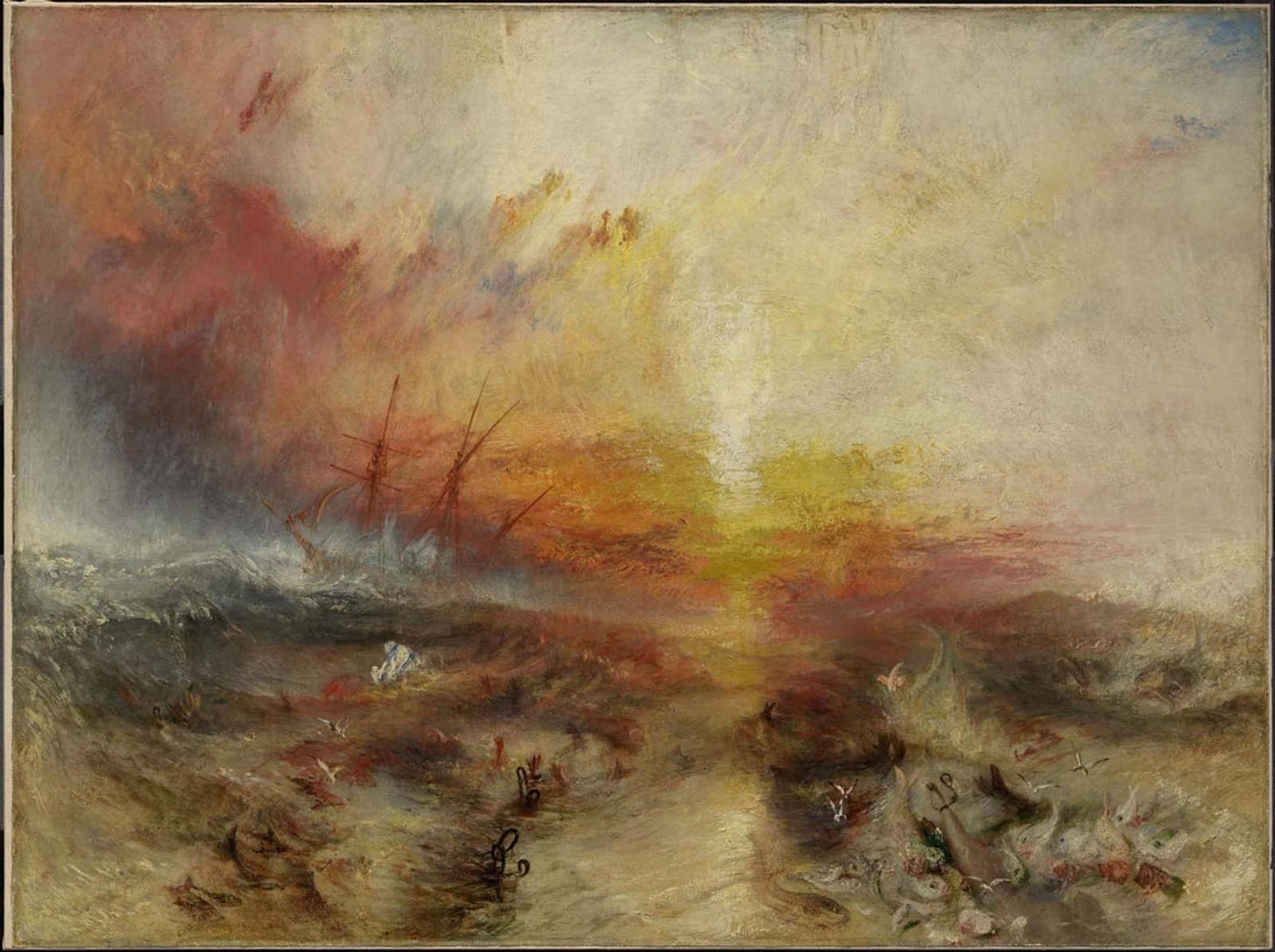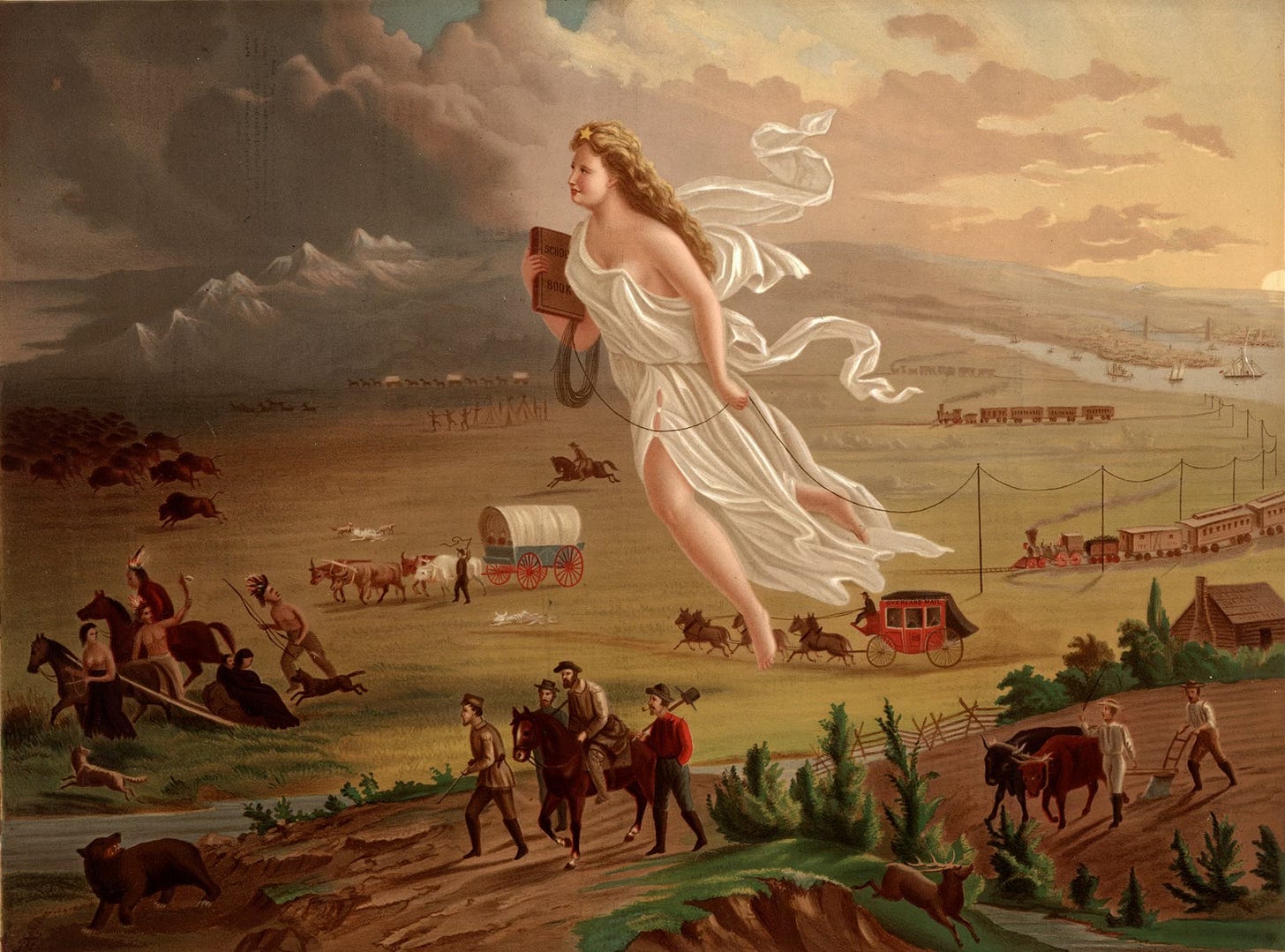All information from the pieces below comes from my experiences seeing these works of art in person. Additionally, I was able to spend an extensive amount of time with each work. Furthermore, in some experiences, I was able to be in conversation with curators & art historians to learn more in-depth information which I now present to you.
Landscape paintings are some of the most intriguing visual works for me to spend time with. Not just because looking at images of nature calms your mind, but because these paintings include layers of history. The land, even strictly paintings of it, is not apolitical. These sites of memory hold stories of history. The works created by the artist’s hand either help to affirm, & uplift these stories or continue pushing them into the background of history as we know it.
Unfortunately, many landscape artists flatten stories to aid in the creation of singular stories that bolster white supremacist capitalist patriarchy (bell hooks). Rather than documenting the sites as portals of memory the artists transform them, with a stroke of a brush, into vacumes. As is the case with Hetch Hetcy Canyon by Albert Bierstadt. The golden light that seems to emanate from the trees on the right moves outwards & upward across the grand rock structures of the scene. This light almost feels ambient as it bathes the land in its warmth.
The only form of life besides plant life is the three deer that appear frail in comparison to the stature of nature. This canyon does not include Indigenous people or those labeled enslaved & treated as property. Expanding upon the foundations The Hudson River School established, Bierstadt contributed to the belief that land was a force to be conquered & divided up (at least to free white men who paid taxes & could vote).

However, Bierstadt wasn’t only expanding on the Hudson River School but more directly the notion of manifest destiny. Three years before Bierstadt painted his vision of the canyon, manifest destiny had been turned into recognizable iconography by John Gast. Gast was commissioned to paint an image that could be included in guidebooks for people traveling west. Both Bierstadt & Gast’s images are violent. Bierstadt's image is violent by the nature of erasure & Gast’s by recording history as it unfolded to achieve it as right. Both stories spill blood & show how empires are built not on flat land but on top of shallow graveyards.
In Gast’s painting, we see the light embodied by a white woman (also clothed in all white)flying from right to left across the scene. Just as the ambient glow of enlightenment blinded the scene of Bierstadt’s documentation of the canyon, Gast personifies the same principle in a person. In the central figures, left-hand we see her lightly carrying a telegraph line with her as she guides white settlers westward. The figure’s gentle grasp on the symbolic representation of innovation is one of the most terrifying things about this image. As the figure is guiding settlers, her gaze is always looking beyond her searching for more. The figure never dares look below or behind her at the Indigenous folk’s way of life being stripped away as they are being pushed off their land by any means necessary. We now know the language for these means is genocide. Within Gast’s work, we also see not just the Indigenous folk being pushed off their land but the buffalo being cleared from the land too. The figure’s forward gaze & loose grip on innovation express a sentiment that if one desires to advance it comes at a price. That price is almost always the lives of folk who know how to live with the land, the land itself, & non-human living kin. To ensure that art engages know exactly where he stood, Gast titled his piece American Progress.
Bierstadt & Gast’s works of art do not honor & document sites of memory while centering the knowledge of the folks who lived with the land. However, there are other landscape artists whose mission is to do just that. In 1840, J.M.W. Turner painted a piece archiving the site of the Zong ship. According to the MFA Boston museum label, where I had the pleasure of seeing this work in person, the Zong was a British slave ship whose “crew murdered 132 sick and dying enslaved Africans by throwing them overboard to collect insurance money for those ‘lost at sea’.” In Turner’s piece entitled Slave Ship (Slavers Throwing Overboard the Dead and Dying, Typhoon Coming On), there is little differentiation between the sky & the sea. The sky & sea merge where art engagers imagine seams would be. Red, blue, yellow, & grey all blend into one another. The sea allows chains along with the people shackled in them. Just above the surface of the water, art engagers can see arms outstretched with grasping hands in the murky foreground.

Turner’s landscape documents the living force of nature, people, & animals in a typhoon of horror. Art engagers are not invited to turn their gaze West but rather inwards to lean toward the piece. The crashing waves gather on the perimeters of the piece creating a shallow area that unveils the truth. Turner used light as a weapon to part the sea, ripping it in two, to invite art engages to see what the records tried to hide. Though as present-day art engages we know the blue sea, on the left hovering above green blood-laced water, will break on the crest of profit. We get to see the crest break thanks to Turner’s work. Although some people did choose the sea, some were forcibly fed to it instead.

Richard Mayhew, a Black & Indigenous artist part of the Spiral Collective, also resisted the delusion of land never being touched & cultivated as home prior to settlers claiming it so. The land holds beauty & the trauma of colonialism, ruins of empire, & chattel slavery. It is impossible to divorce the two from each other. As the trees exhaled oxygen someone took their last breath. When someone releases a deep sigh from stepping outside someone’s lungs are choking on smog from a chemical plant a short distance from their home. This sentiment is one that Richard uses to captivate art engages. Though Richard doesn’t include people's physicality in his work to debunk the pastoral, he imbues his pieces with the presence of folks known & unknown to him. In Delusions, Richard archives the site of a Louisiana plantation he visited. According to the label of Delusions at the San Franciso Museum of Modern Art during Richard’s visit, he felt “a ghostly presence of historical suffering but also of immanent empowerment.” Richard disturbs the illusion that people & the land can be conquered through this piece. Richard creates a piece with increased saturation & a blurred quality to it. Delusions makes the art engager question the delineations of the site of the plantation & ask what now?

J.M.W., M. NourbeSe Philip, & Richard sat with the sites of memory to create art that archives other wasy of knowing. These artist’s three pieces affirmed the stories the sites held, documented the stories that emerged, & presented them to an audience. This process is reflected within the Assemblage framework that I invite you to actively practice within the fall 2024 Clearing cohort. In The Clearing, we will learn how to walk with the stories of the land we gather, create three archival art pieces, & return to an aligned life. Maybe you will take an approach similar to Richard's by visiting your site of memory & using the Assemblage framework to develop a series of photographs. Perhaps there is a site you can no longer visit but recall your elders reminiscing over. Therefore, you like M. NourbeSe Philip conjure a written piece between the sparse linings of the archive. What other ways will you dream up to document & preserve the sites of memory in your life?
🌀 Enrollment for The Clearing is open now & closes this Thursday, October 17th, 2024.
Let’s find out the other ways you will document & preserve the sites of memory in your life together in The Clearing! The Assemblage Conservatory Clearing is a 9-week griot in training program where you will go from feeling disconnected to the land you walk on, feeling ungrounded, & difficulties navigating the tides of life to feeling rooted walking with the stories of the land you gather through archival art making through the Assemblage framework.
The Clearing Fall 2024 Cohort will be capped at 10 unruly folks. So be sure to gather the information you need & enroll today to meet us in The Clearing by clicking the button below. Still, have lingering questions? You can still book a discovery call now through this Thursday (October 17th, 2024) by clicking the same button below.
Share the flyer below with someone who has been searching for a Clearing in their life! I hope we will get to practice gathering & honoring together inside The Clearing of our dreams knowing that reality is a dream’s worst nightmare & a dreamer’s worst nightmare is reality ✨. Meet you in the clearing?

Please remember if you choose to quote this piece, share this piece, or any piece on this publication to always CITE BLACK WOMEN. Please always include my name (Kay Brown she/her pronouns) and a link to the publication of the Assemblage: Baby’s Breath substack in your sharing practice.
To further support my writing practice, receive additional offerings that connect to my pieces, & be the first to hear about other ways to engage in the theory of Assemblage, please consider becoming a paid subscriber.
Lastly, remember that referrals are now available! This means you get to speak the name Assemblage: Baby’s Breath out loud to your community while receiving unique grounded gathered gifts from me. Thank you for being here 💙.






Wow I’ve never seen that Mayhew painting. Gorgeous 😍